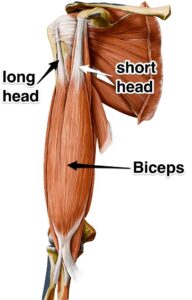Push ups for biceps? Shedding light on the fallacy
The misconception that push-ups effectively sculpt biceps:
Push ups for biceps? Numerous fitness enthusiasts and novices mistakenly believe that push-ups, being a compound exercise engaging multiple muscle groups, are a potent means of targeting and building the biceps.
Debunking misconceptions surrounding push-ups and their impact on biceps:
Some individuals hold the mistaken belief that the pushing motion inherent in push-ups automatically triggers biceps activation and growth, assuming that this exercise similarly stimulates the biceps to dedicated biceps exercises such as curls. Most people do push ups for biceps growth and don’t see considerate results.
Purpose of the article:
This article aims to dispel the erroneous notion that push-ups are a superior exercise for biceps development. We will delve into the biomechanics and muscle activation involved in push-ups to comprehend why they do not primarily target the biceps.
Presenting evidence-based insights into the efficacy of push-ups for biceps growth: Through meticulous research and expert perspectives, we will provide a well-rounded understanding of push-ups and their impact on biceps strength and size. This will empower readers to make informed decisions when incorporating push-ups into their biceps training regimen.
Stop doing push ups for biceps! While push-ups offer numerous benefits for overall upper body strength but it isn’t optimal for bicep growth.
Biceps Anatomy Unveiled
A. Structure and function of the biceps muscle:

The biceps muscle, scientifically known as the biceps brachii, is a two-headed muscle situated in the upper arm. It comprises a long head and a short head, originating from distinct points on the scapula.
The muscle fibres merge into a solitary tendon that attaches to the radius bone in the forearm. The primary function of the biceps is elbow flexion, entailing the bending of the forearm towards the upper arm. Additionally, the biceps also contribute to shoulder flexion and forearm supination.
B. The bicep’s role in arm movements:
The biceps muscle assumes a pivotal role in various arm movements. During elbow flexion, the biceps contract, pulling the forearm towards the upper arm, facilitating actions like lifting objects or performing curls. The biceps also lend support to shoulder flexion, actively participating in raising the arm forward.
Furthermore, the biceps assist in forearm supination, which encompasses the rotation of the palm from a downward-facing position to an upward-facing position.
Introducing alternative exercises specifically designed to isolate and engage the biceps for optimal outcomes:
Stop doing push ups for biceps! While push-ups offer numerous benefits for overall upper body strength, we will recommend alternative exercises that specifically target and activate the biceps to maximize their growth potential. These exercises will equip readers with effective strategies to augment their biceps training routine.
In the pursuit of well-developed biceps, certain exercises have proven to be highly effective. While it is crucial to emphasize isolation exercises that directly target the biceps, compound exercises involving multiple muscle groups also engage the biceps to a certain degree. Here are some optimal exercises for biceps development:
Bicep curls:
Instead of doing push ups for biceps development, focus on isolate exercises like Bicep Curls. This exercise exclusively targets the biceps by flexing the elbow joint against resistance. Dumbbells, barbells, or cables can be used for this purpose.
Hammer curls:
Similar to bicep curls, hammer curls primarily focus on the biceps but employ a different grip that emphasizes the brachialis muscle beneath the biceps.
Preacher curls:
By utilizing a preacher bench, preacher curls isolate the biceps effectively. This bench aids in stabilizing the upper arm, preventing cheating or momentum during the exercise. These exercises are a great substitute of push ups for biceps.
Unveiling the Nature of Push-Ups
A. Description and advantages of push-ups:
Push-ups are a classic form of bodyweight exercise that primarily targets the muscles of the upper body. To perform a push-up, one starts in a prone position with hands slightly wider than shoulder-width apart, lifting the body off the ground. The individual then lowers their body by bending the elbows until the chest is close to or touches the ground, subsequently pushing back up to the starting position. Push-ups offer numerous advantages, including:
1-Strengthening the chest, shoulders, and triceps
2-Engaging the core muscles to enhance stability
3-Improving overall upper body strength
4-Enhancing muscular endurance
5-Encouraging functional movement patterns
B. Muscles involved in push-ups:
Push-ups activate multiple muscle groups throughout the body. The primary muscles involved are:
Chest muscles (pectoralis major and minor): These muscles facilitate the horizontal adduction of the arms, bringing them closer together during the pushing phase of a push-up.
Shoulder muscles (deltoids): The deltoids assist in shoulder flexion and abduction while performing push-ups.
Triceps brachii: The triceps muscles are engaged during the pushing phase to extend the elbow joint.
Core muscles: Muscles such as the rectus abdominis, obliques, and transverse abdominis provide stability during the exercise, ensuring proper form and preventing excessive sagging or arching of the back.
C. Primary emphasis of push-ups:
While push-ups involve several muscle groups, their primary emphasis is on the chest muscles (pectoralis major and minor) and the triceps. These muscles are the primary drivers behind the pushing motion during a push-up. Biceps contribute to stability during push ups, but doing push ups for biceps growth isn’t a wise move.
Dispelling the Myth: Debunking the Fallacy of Push-Ups for Biceps Development
A. Insufficient biceps isolation in push-ups:
The predominant reason push-ups are not an optimal choice for biceps development lies in their lack of isolation. Push-ups are compound exercises that engage multiple muscle groups simultaneously.
Although the biceps participate as stabilizers during push-ups, they are not the primary muscles targeted. As a result, the biceps do not experience enough direct stimulation to induce substantial growth. You should immediately stop using push ups for biceps development.There are no specific push ups variations for biceps
B. Limited range of motion for biceps engagement:
Another factor that hampers biceps activation during push-ups is the limited range of motion. In a standard push-up, the elbow joint undergoes flexion and extension, but the range of motion remains relatively restricted when compared to dedicated biceps exercises like curls.
For effective biceps stimulation, a complete range of motion encompassing both flexion and extension is necessary. Push-ups, with their constrained range, do not offer the ideal conditions for optimal biceps engagement.
C. Emphasis on chest and triceps in push-ups:
Push-ups prioritize the involvement of the chest muscles (pectoralis major and minor) and triceps, diverting the focus away from the biceps. The pushing motion and hand placement during push-ups accentuate these muscle groups rather than the biceps. The chest muscles are responsible for horizontally adducting the arms, while the triceps actively contribute to elbow extension.
Although the biceps play a supportive role as stabilizers, their contribution is insufficient to elicit significant biceps growth. So, If you are doing push ups for biceps then you are unintentionally targeting the chest and tricep muscles.
V. Alternative Exercises for Biceps Development
A. Bicep curls: Technique and Variations:
Bicep curls represent one of the most effective exercises for targeting and sculpting the biceps. The fundamental technique involves gripping a dumbbell or barbell with an underhand grip, commencing with the arms fully extended, and subsequently flexing the elbows to raise the weight towards the shoulders.
Key considerations for executing bicep curls include maintaining proper form, avoiding excessive swinging or momentum, and emphasizing controlled movements.
Various variations of bicep curls exist to challenge the biceps from different angles, including incline curls, concentration curls, and cable curls. That’s why it’s better to do one of these exercises instead of doing push ups for biceps.
B. Hammer curls: Technique and Advantages:
Hammer curls serve as a variation of bicep curls that specifically target the brachialis muscle, situated beneath the biceps. This technique entails grasping dumbbells with a neutral grip (palms facing each other), maintaining elbows close to the sides, and flexing the elbows to raise the weights while preserving the neutral grip throughout the motion. Hammer curls offer several advantages, such as enhanced development of the brachialis, increased forearm strength, and improved grip strength.
C. Preacher curls Technique and Focused Biceps Activation:
Preacher curls involve performing curls while resting the upper arms on a preacher bench, which provides support, restricts cheating or swinging, and isolates the biceps. The technique entails sitting on the preacher bench, placing the upper arms against the angled pad, and executing curls by flexing the elbows and lifting the weight towards the shoulders. Preacher curls ensure targeted biceps activation by minimizing the involvement of other muscle groups, enabling precise concentration on the biceps.
Compound movements for overall strength and aesthetics:
In addition to incorporating targeted exercises for the biceps and triceps, integrating compound movements into your arm workouts can contribute to overall arm strength and aesthetics. Compound exercises engage multiple muscle groups simultaneously, providing a functional and efficient approach to training. Some compound movements that benefit arm development include:
Bench press:
This exercise primarily targets the chest muscles but also involves the triceps as secondary movers.
Pull-ups/chin-ups: These exercises engage the back muscles, including the biceps, providing a compound movement for arm development.
Overhead press:
This exercise primarily targets the shoulders but also recruits the triceps, contributing to overall arm strength. It’s a great compound exercise that you should incorporate into your exercise regimen.
Maximizing Biceps Growth and Strength
A. Progressive overload principles for biceps training:
To maximize biceps growth and strength, it’s important to incorporate progressive overload principles into your training. This involves gradually increasing the demands placed on the biceps over time. Effective ways to apply progressive overload to biceps training include:
Increasing resistance: Gradually increase the weight or resistance used during biceps exercises.
Adding repetitions: Aim to perform more repetitions with proper form over time.
Adjusting sets and frequency: Increase the number of sets or the frequency of biceps workouts to provide a greater stimulus for growth.
Varying exercise selection: Continually challenge the biceps by incorporating different exercises, variations, or training techniques.
B. Importance of nutrition and recovery:
Maximizing biceps growth and strength also relies on proper nutrition and adequate recovery. To support biceps development, ensure you:
Consume a well-balanced diet: Provide your body with sufficient protein, carbohydrates, and healthy fats to support muscle growth and repair.
Stay hydrated: Proper hydration is essential for optimal muscle function and recovery.
Get enough rest: Allow your biceps and the rest of your body to recover through adequate sleep and rest days between workouts.
C. Designing an effective biceps-focused workout routine:
Designing an effective biceps-focused workout routine involves considering various factors, including exercise selection, volume, frequency, and intensity. Some key points to consider when designing a biceps-focused workout routine include:
Prioritize compound exercises: While isolation exercises are important for biceps development, also include compound movements that engage multiple muscle groups.
Incorporate progressive overload: Gradually increase the demands placed on the biceps over time, as discussed earlier.
Include adequate rest and recovery: Allow sufficient time for the biceps to recover between workouts to avoid overtraining.
Conclusion
Recap of debunked myth:
In this article, we have successfully debunked the myth that push ups for biceps, alone are sufficient for significant biceps growth. We discussed the reasons why push ups for biceps development aren’t effective, including the lack of biceps isolation, limited range of motion, and the primary emphasis on chest and triceps activation during push-ups. Understanding the limitations of push-ups allows us to explore more effective alternatives for targeting the biceps directly. So, now you know why you shouldn’t do push ups for biceps development.
B. Final thoughts on biceps training:
Biceps training requires a comprehensive approach that extends beyond push-ups. While push-ups are excellent for overall upper-body strength and muscular endurance, they are not the primary drivers of biceps growth. Instead, exercises like bicep curls, hammer curls, and preacher curls offer better biceps isolation, range of motion, and targeted activation. They prove particularly effective in developing the biceps’ peak and enhancing overall biceps shape. So, Please! stop using push ups for biceps growth.
FAQs
1- Is doing push ups for biceps good?
No, certainly not. As we have explained above, doing push ups for bicep development isn’t a wise approach.
2-How long does it take for the biceps to grow?
It depends on several factors that include your diet, training volume, training frequency and self-discipline. It doesn’t have a specific answer.
3-How to do push ups for biceps?
As we’ve discussed above, push ups do engage biceps to a certain extent but there are no specific variations of push ups to target biceps muscles.
Also, Check out My Fitness Journey
Hello, fellow fitness enthusiasts! I'm Zayn, a Board Certified Fitness and Nutrition Coach. My journey started from a personal commitment to fitness, and over time, this passion ignited a desire to help others unlock their potential. I transformed this passion into my profession, and today, I'm proud to say that I am armed with a plethora of certifications, all testament to my dedication and commitment.
When I'm not advising clients or working on my next blog post, you'll find me trying out new fitness regimes, diving into the latest nutritional research, or practicing what I preach with my own healthy lifestyle. My mission is to help you become the best version of yourself, showing that fitness and nutrition are as much about the journey as they are about the destination.


